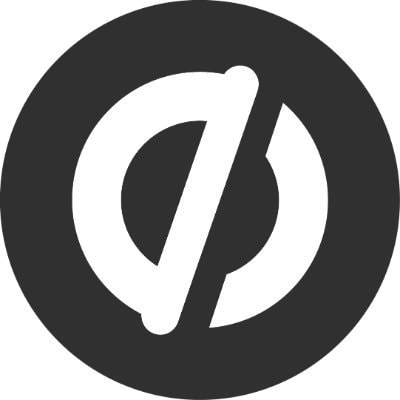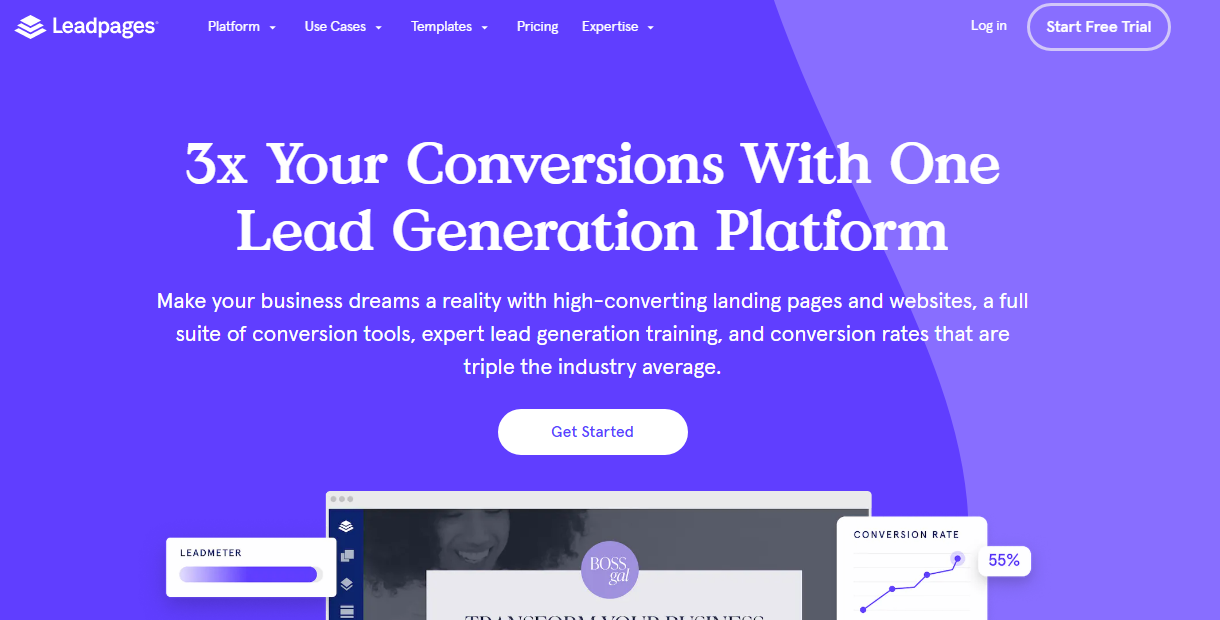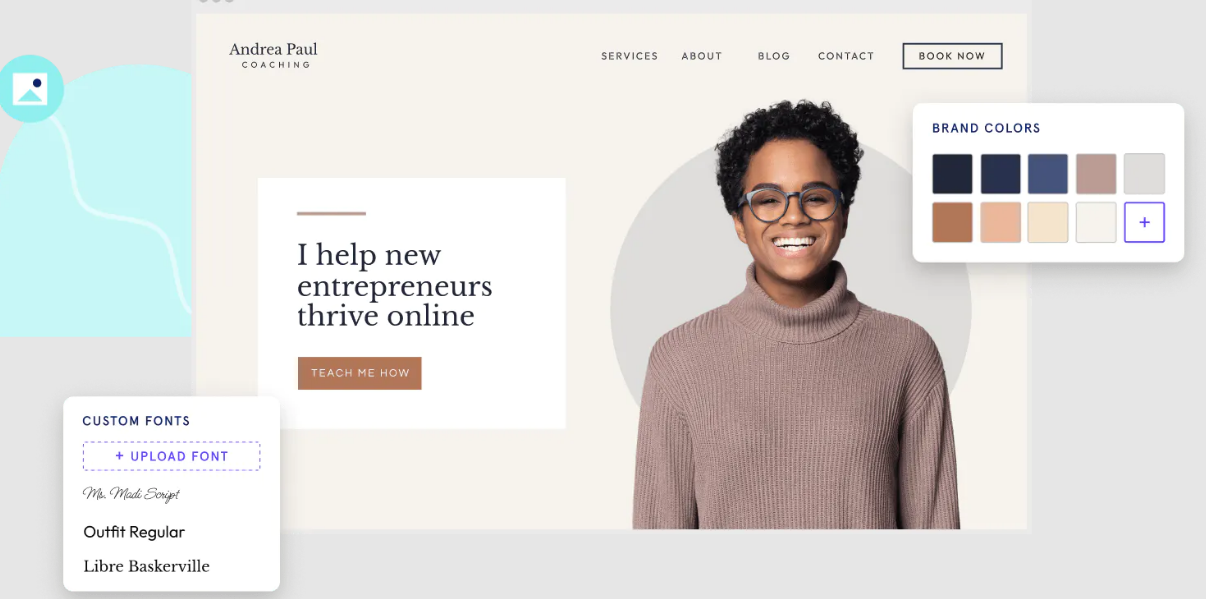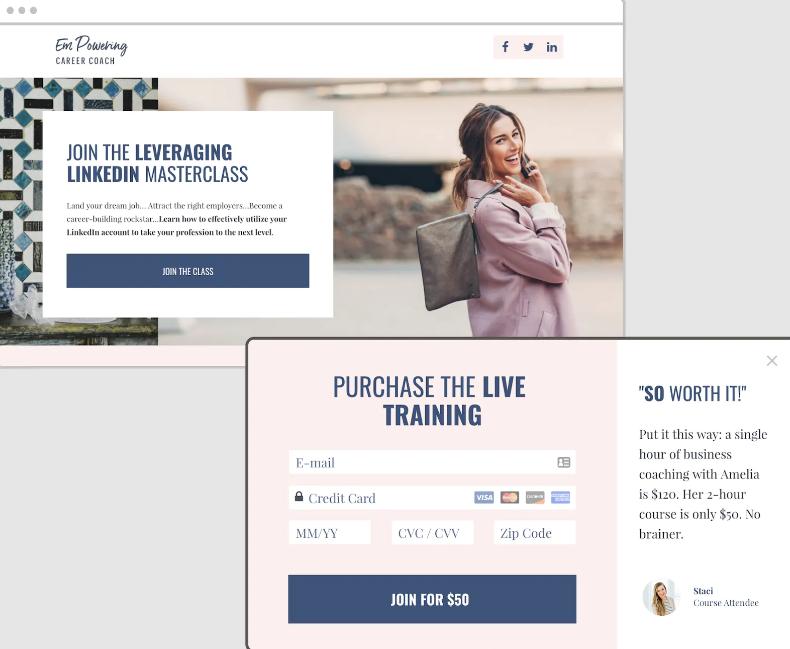Hey there! If you’re diving into the world of online marketing and building landing pages, you’ve likely come across two fantastic tools: Leadpages and Unbounce.
I’ve had the chance to work with both, and let me tell you, they each bring their own unique flavors to the table.
In the end, whether you lean towards Leadpages or Unbounce depends on your specific needs and comfort level with design and testing.
Both tools have their strengths, and either can help you create high-converting landing pages that will drive your online marketing efforts to success. So, take a closer look, experiment, and choose the one that feels like the best fit for your digital marketing journey.
Content Outline
Main Differences Between Leadpages vs Unbounce
The primary distinctions between Leadpages and Unbounce are as follows:
- Unbounce provides more flexibility and customization options, whereas Leadpages works well right out of the box and has more defined landing pages.
- Unounce is less expensive, starting at $90 per month, whereas Leadpages is more expensive, beginning at $149 per month.
- Leadpages provides superior analytics and reporting via heat maps, whereas Unbounce only provides basic native reporting functionality.
- Unbounce provides more advanced customizable exit-intent popups, whereas Leadpages provides basic popup functionality.
Unbounce
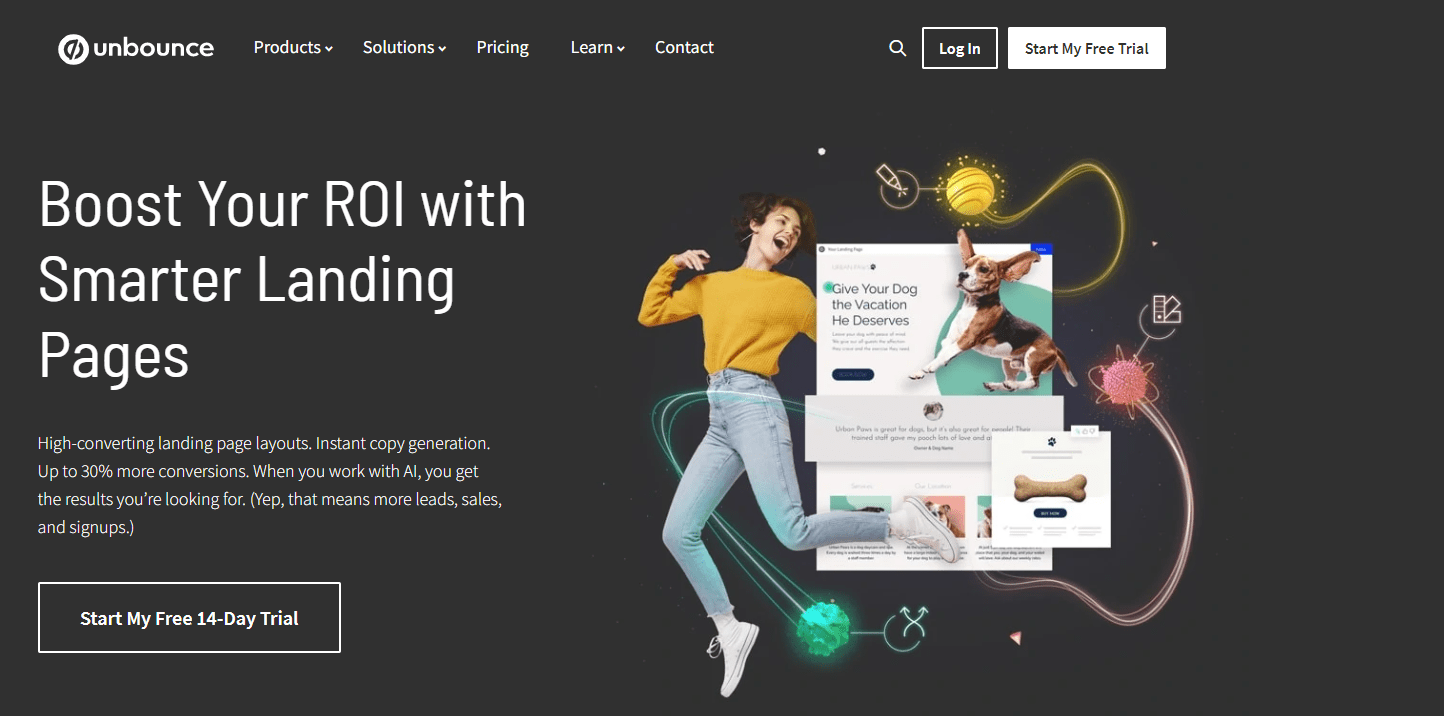
Unbounce, which was founded in 2009, is the pioneer of landing page builder services. It influenced the likes of Leadpages and LeadPages three years later.
According to Unbounce, its main goal is to assist marketers in converting more browsers into leads (lead generation), prospects, and customers. The Leadpages alternative is completely web-based, offers a free trial, and has a robust ecosystem built around its landing page builder.
Leadpages
Overall, a great landing page tool for both beginners and experts, with plenty of options (except for the lack of popups) and an easy-to-use editor.
It’s my favourite because it’s so simple and straightforward. It has the feel of the “Apple” of landing page software. The Leadpages editor is straightforward, attractive, and completely drag-and-drop!
Furthermore, installation is a breeze. As with most landing page software tools, hosting Leadpages on your site is as simple as flipping a switch in your domain settings. If you have WordPress, you can integrate it with a single click.
1. Ease of Use:
LeadPages
Leadpages’ user-friendly platform allows anyone to build and launch a professional landing page in no time, often within just a few hours.
The intuitive Drag-and-Drop Builder is a game-changer. You can effortlessly move content, add elements, and make edits without any coding skills or design expertise. Leadpages’ system, organized into sections, rows, and columns, ensures that your content aligns perfectly, resulting in a polished look that screams professionalism.
What sets Leadpages apart is the Leadmeter feature. As you construct your landing page, it predicts its conversion potential and offers actionable recommendations for optimizing images, copy, and layout.
This guidance, rooted in industry best practices, empowers you to create a high-converting landing page, even if you’re new to conversion optimization.
But if you’re itching for more customization, Leadpages has you covered. While beginners can create stunning pages without touching a line of code, experienced coders can dive into advanced customization using the HTML widget and CSS adjustments. You can even upload custom fonts to infuse your page with your desired aesthetic.
Leadpages strikes the perfect balance between simplicity and versatility, ensuring that both novices and experts can craft landing pages that captivate and convert.
Unbounce:
Unbounce stands out as a robust and highly adaptable landing page builder that caters to both desktop and mobile devices.
Its versatility shines through in its user interface, offering a user-friendly drag-and-drop feature for beginners while granting advanced users the freedom to dive into JavaScript and CSS customization.
One unique aspect of Unbounce’s drag-and-drop editor is its grid-free approach, providing users with greater creative flexibility when designing pages and positioning elements.
However, this freedom also calls for a bit more expertise and precision when placing elements exactly where you want them.
It’s essential to be aware that Unbounce doesn’t offer a direct counterpart to Leadpages’ Leadmeter feature.
If you’re new to the world of conversion rate optimization, you may need to invest some additional time in research and learning before constructing your initial landing page.
Nevertheless, Unbounce’s rich feature set and flexibility make it a valuable tool for creating highly customized, conversion-focused landing pages.
Verdict: Leadpages is user-friendly and great for beginners, while Unbounce offers more customization options for experienced web designers.
2. Functionality:
LeadPages:
Leadpages offers robust integration capabilities with over 90 well-known online marketing tools. Additionally, it provides access to an extensive library of more than 2,000 additional integrations through Zapier.
This ensures that regardless of the specific tools and applications you rely on for your business, Leadpages can seamlessly connect with them to enhance your landing page functionality.
Among the notable Leadpages integrations are Stripe for payment processing, Calendly for scheduling consultations, MailChimp and AWeber for email marketing, and OpenTable for handling restaurant reservations.
Unbounce:
Unbounce boasts an extensive collection of integrations totaling 116 in number. These integrations encompass a wide array of essential business and marketing tools, encompassing major ESPs, CRMs, webinar platforms, and social networks.
This impressive selection covers virtually all the popular tools commonly used in the industry.
Furthermore, similar to Leadpages, Unbounce offers the flexibility to connect with additional tools through Zapier, opening up even more possibilities for integration.
Verdict: Unbounce and Zapier both integrate well, with Unbounce having more built-in options and Zapier leveling the field with compatibility.
3. Look & Feel:
Leadpages:
Leadpages offers a significant advantage through its extensive template library, boasting over 220 professionally crafted landing page templates and over 50 website templates.
These templates are meticulously designed to maximize conversions, ensuring that you can expect the desired results no matter your choice. Leadpages simplifies the template selection process by enabling you to filter them by industry, style, and color.
Alternatively, if your primary objective is lead generation, you can sort templates based on their conversion rates, allowing you to identify the top-performing options.
Furthermore, each template is optimized for mobile responsiveness, guaranteeing that your pages maintain their intended appearance across all devices. You also have the flexibility to add or hide sections depending on the device used to view them.
Unbounce:
Unbounce offers a wide selection of over 151 landing page templates, including categories for landing pages, sticky bars, pop-ups, and designs optimized for AMP (Accelerated Mobile Pages).
While it doesn’t provide the option to sort templates by conversion rate, you can easily filter them based on industry, campaign type, name, recent additions, or popularity. This makes it convenient to discover a template that suits your brand, campaign, or promotional needs.
Unbounce allows you to preview your page on both desktop and mobile devices. While some elements may require manual adjustments for mobile responsiveness, unlike Leadpages’ automatic mobile optimization, Unbounce’s mobile editing interface is user-friendly and intuitive.
Verdict: I would advise you to explore the template galleries of both platforms to determine which one aligns better with your personal preferences.
4. Conversion Tool:
LeadPages:
Leadpages is fundamentally a conversion-focused platform. Its primary objective is to transform your website traffic into valuable leads and sales. It achieves this goal by providing a diverse set of powerful conversion tools:
- Leadmeter: This tool assesses the performance potential of your web pages and provides recommendations for improvements before you publish them.
- Alert Bars: These are prominent text bars placed at the top of your pages, enabling you to promote lead magnets, special offers, events, and other key content to engage your audience.
- Pop-ups: Pop-ups are strategically placed to grab the attention of potential customers either when they first arrive on your site or when they are about to leave, increasing the chances of conversion.
In addition to these features, Leadpages offers conversion tracking, unlimited A/B testing capabilities, and seamless payment integration through Stripe. Furthermore, Leadpages provides a vast library of professionally designed templates, all meticulously crafted to optimize conversion rates.
Unbounce:
Unbounce lives up to its name by focusing on minimizing bounce rates and effectively converting website traffic into valuable leads. Their template designs are geared towards optimizing conversion rates, ensuring a strong start on your path to success.
Unbounce provides features like sticky bars and pop-ups, simplifying the promotion of offers or content downloads. Furthermore, A/B testing capabilities are accessible across all plan levels.
When it comes to managing your leads, Unbounce streamlines the process of transferring this valuable information to customer relationship management (CRM) systems and marketing automation tools.
You can seamlessly integrate with popular platforms such as Salesforce, Zoho, HubSpot, Mailchimp, and more, making your lead management and nurturing efforts even more efficient.
5. Traffic
LeadPages:
Leadpages provides an intuitive analytics dashboard, offering real-time data on metrics like visitor count, conversions, and conversion rates. This dashboard offers a comprehensive overview of your page’s performance.
Additionally, Leadpages offers valuable SEO tools. You can easily enhance your search engine optimization by utilizing features like SEO settings and previews. These tools allow you to edit essential elements like meta titles, keywords, and descriptions, ensuring your page is well-optimized for relevant search terms.
One standout feature of Leadpages is its exceptional page load speed, which is, on average, 2.4 seconds faster than competitors. This contributes to improved SEO and results in lower bounce rates and higher conversion rates.
Unbounce:
Unbounce offers an impressive feature known as AMP landing pages, which signals to Google that your webpage boasts exceptional speed. This speed is so remarkable that Google denotes it with a distinctive gray lightning-bolt logo when accessed on mobile devices.
Similarly to Leadpages, Unbounce simplifies the process of editing your metadata. To personalize your meta title, keywords, and description, all you need to do is click on “Page Properties” within the builder.
Furthermore, Unbounce provides comprehensive real-time performance analytics that goes beyond the fundamental data offered by Google Analytics.
Verdict: Both platforms offer advantages in this aspect. They both provide real-time analytics and user-friendly dashboards that effectively display traffic and conversion rates.
6. Pricing Value:
LeadPages:
- Standard: $37 per month.
- Pro: $74 per month.
- Advanced: Custom pricing based on your business needs. You need to inquire with Leadpages to get pricing details for this plan.
Unbounce:
- Launch: This plan was priced at $99 USD per month. It is likely designed for individuals or smaller businesses looking to create and optimize landing pages for their marketing campaigns.
- Optimize: The Optimize plan was priced at $145 USD per month. It might offer more features and capabilities than the Launch plan, making it suitable for businesses with slightly more advanced needs.
- Accelerate: This plan was priced at $240 USD per month. It probably offers even more features and advanced tools for businesses with larger marketing budgets and more complex landing page requirements.
- Concierge: The Concierge plan was the most premium option, starting at $625 USD per month. It likely includes dedicated support and additional services, making it suitable for larger enterprises or businesses that require a high level of customization and support.
Email Marketing:
LeadPages:
In the ever-evolving digital marketing landscape, one strategy has stood the test of time, consistently delivering an impressive return on investment (ROI) of 4,400% on average: email marketing.
Leadpages, a dynamic marketing platform, recognizes the pivotal role email marketing plays in engaging audiences and converting leads into loyal customers.
With its array of features and tools, Leadpages empowers businesses to harness the true potential of email marketing campaigns.
Unbounce:
Unbounce’s email marketing solutions are designed to bridge the divide between email engagement and conversion. With Unbounce, you can transform email clicks into tangible sales and signups by creating dedicated landing pages that align seamlessly with your email campaigns.
These tailored landing pages ensure that your audience’s journey remains consistent, from the moment they open your email to the final conversion step.
By delivering a cohesive and customized experience, Unbounce empowers businesses to maximize the impact of their email marketing efforts, driving higher conversion rates and ultimately, greater success in their online marketing endeavors.
Pros & Cons of LeadPages vs Unbounce:
LeadPages:
| Pros | Cons |
| ✔️ User-Friendly Interface | ✖️ Traffic Limits |
| ✔️ Professionally designed templates | |
| ✔️ Integrates seamlessly with email marketing | |
| ✔️ Competitive pricing | |
| ✔️ Lead Generation Tools |
Unbounce:
| Pros | Cons |
| ✔️ Advanced Customization | ✖️ Steeper Learning Curve |
| ✔️ SSL encryption and GDPR compliance | |
| ✔️ Dynamic Text Replacement | |
| ✔️ Wide range of third-party tools and platforms | |
| ✔️ Robust A/B testing tools |
So which landing page tool is better?
When comparing Unbounce versus Leadpages and Leadpages, you can see that all three tools perform admirably. Each has distinct advantages and disadvantages that will be more important to different types of users. Here are the main tool differences and who each is best suited for to help you decide which is best for your needs:
- Use Unbounce if you want the most flexibility and customization options when creating pages. Ideal for experienced online marketers with advanced landing page requirements.
- If you have a larger budget and want a great overall tool for creating landing pages, use Leadpages. Ideal for online marketing teams with moderate landing page requirements.
Quick Links:
Conclusion: Leadpages vs Unbounce 2024?
In conclusion, when comparing Leadpages and Unbounce, both platforms offer powerful tools for creating high-converting landing pages and optimizing your online marketing efforts. Your choice between the two should largely depend on your specific needs and preferences.
Ultimately, the decision between Leadpages and Unbounce should be based on factors such as your level of experience, budget, and the complexity of your landing page requirements.
Both platforms can help you create compelling landing pages, but the choice comes down to which one aligns better with your unique objectives and resources.


